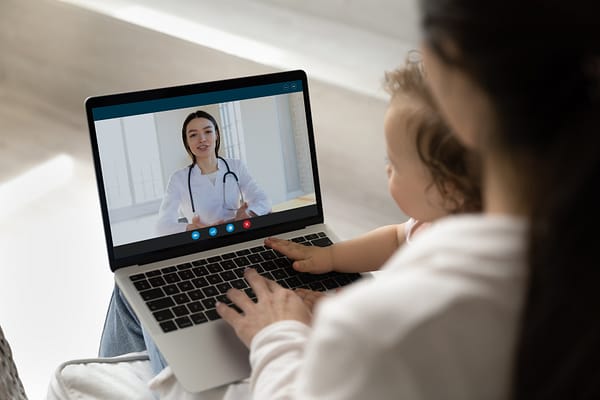Families with children in Ontario commonly utilize pediatric services for their primary care needs. Canadian pediatricians are responsible for a number of duties and often specialize in one or more areas of youth childcare. A few of the ways these healthcare professionals practice include providing primary care, hospital care, and consulting to patients between the ages of 0 and 18.
Traditionally, most pediatric care is delivered in-person, whether it be providing regular appointments, examinations, immunizations, or promoting health to young patients. While in-person care is the accepted delivery method for general pediatrics, some specialty pediatrics care, particularly those that require close patient monitoring, can be enhanced with remote patient management.
Here, we’ll dive into the features of remote patient management, and the benefits it can bring to Ontario-based pediatricians and their patients.
The Importance of Monitoring Children With Chronic Illnesses

For children suffering from a chronic illness, regular monitoring of health status through virtual platforms can be a non-invasive way to track the child’s status, while minimizing interference with their day-to-day life.
The most common chronic diseases children can have include asthma, cystic fibrosis, diabetes, and epilepsy. Traditional care methods require children with these diseases to make frequent visits to a clinic, and have a parent or other adult check and monitor their vitals. This can be a very consuming process and interfere with the child’s quality of life. With remote patient management, all of this can be done online and frequently without the child’s involvement, meaning there’s more time for them to have fun and enjoy their childhood like their peers.
Delivering Pediatrics Care Remotely in Ontario
With remote patient management, pediatricians have a comprehensive platform to deliver care. Through these fully integrated remote patient management platforms, pediatricians can complete many healthcare processes. From virtual visits and check-ins with patients, to complete patient management for youth with chronic health conditions. In addition to improving access to pediatric healthcare services in Ontario, platforms like aTouchAway can simplify several pediatric care processes, reducing the workloads of pediatricians and helping them care for more patients.
Benefits of Remote Patient Management For Pediatrics

Better Monitoring in Remote Communities
One of the most beneficial aspects of pediatric remote patient management is its ability to connect children with healthcare providers, no matter where they are located. This is especially helpful for children living in rural or remote communities. In Ontario, roughly 14% of the population live in rural areas (population of less than 1,000) and an additional 10% reside in communities with fewer than 30,000 people. In some of these northern communities, pediatric healthcare services are either extremely scarce or non-existent.
In addition to reduced access caused by location, many children can struggle with travelling to and from healthcare appointments due to health factors, even if they have access to a pediatrician in their city. With remote patient management, pediatricians can increase access to their services by allowing patients to communicate and receive care virtually. In doing so, children can receive the care they need from the comfort of their own home or community, without having to haul medical equipment to and from appointments. Overall, this can enhance the care experience for pediatric patients and allow them to spend more time doing the things they enjoy.
All Care Circle Members Can Be In The Loop
As pediatric care deals with the health of children, there are likely to be several members included in a patient’s care circle. This can include the parents of the child, grandparents, their pediatrician, and any other healthcare workers who are involved with their care. Oftentimes, minors will need to be accompanied by a parent or guardian during their healthcare visits. For chronic illnesses, it’s important that the entire care team is up to date on the child’s health needs and know what the responsibilities are for providing at-home care.
To ensure all members of a patient’s care circle are on the same page, pediatricians can provide special access through their remote patient management platform. Here, different members can communicate directly with one another, and can even be present for medical appointments through video conferencing. This can be especially helpful for families who are separated as they can be involved in their child’s healthcare from anywhere with an internet connection.
Remote Monitoring for More Interactive Care
When providing healthcare services to children, it’s important that the care they receive is interactive to keep them engaged. With remote patient management, there are several features that can greatly increase the engagement levels of young patients. Through the platform, pediatricians can utilize existing care plans and patient education to ensure their patients are on track with their health progress, while also keeping them motivated.
Providers can input customized care pathways for common childhood illnesses including diabetes, asthma, or epilepsy. Through these pathways, patients and members of their care team can receive instructions on how they should care for the illness, and can input new symptoms or health data collected by monitoring equipment if they require it. Patients can then receive additional educational resources to help aid in their health progress automatically depending on the symptoms they are experiencing.
Another way remote patient management can keep young patients engaged is by allowing them to have questions or concerns answered directly through the platform they use. For example, a patient with a respiratory illness who requires a ventilator can send an instant message to their pediatrician should they experience any challenges with the equipment, or have any questions on how to use it.
Home Mechanical Ventilation in Pediatrics
Interventions such as mechanical ventilation become necessary when a child struggles to breathe independently. In the case where this is supporting a chronic condition, the child may constantly require some degree of breathing support. Across Canada, home mechanical ventilation (HMV) patients are traditionally associated with high public and private healthcare costs, as a result of frequent emergency room visits, as well as high at-home care costs.
Traditionally, most pediatric care is delivered in person, whether it be providing regular appointments or at-home care for promoting health in young patients. While in-person care is the generally accepted delivery method for pediatrics, some specialty pediatrics care, including HMV could be improved with remote patient management. Emerging remote patient management systems are specializing in enhancing the depth of care for different treatments. One platform, based in Ontario, that can be used to handle multiple aspects of patient care is aTouchAway.
Through this fully integrated platform, pediatricians can complete many healthcare processes. For example, the Long-Term In-Home Engagement (LIVE) program supports children remotely by collaborating with providers, ventilators specialists, and family members to better support the child. In addition to improving access to pediatric healthcare services in Ontario, platforms like aTouchAway can simplify several pediatric care processes, reducing the workloads of pediatricians and helping them care for more patients.
Continuing To Improve Chronic Illness Management in Pediatrics

Children living with chronic illnesses can greatly benefit from the close monitoring remote patient management offers. Through this system, there is low involvement on the child’s end, while increasing the depth of care they receive. By allowing young patients to access pediatric services, no matter where they are in the province or what their circumstances are, long-term health outcomes can continue to improve.
Thank you for reading. To stay up to date on current healthcare topics and news about Aetonix, subscribe to our mailing list at the bottom of our blog page. Connect with us on social media using the links at the bottom of this page and share your thoughts!

